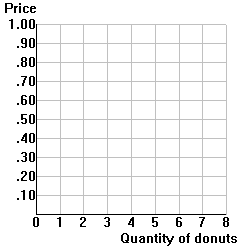Consider a product-market example: the demand for donuts:
Use the information below to construct a demand curve for the 8 most highly-valued donuts in the diagram to the right:

| Jim Whitney | Economics 101: Section 2 |
Each buyer's individual demand curve comes from the buyer's benefit-cost
rule: Buy another unit if its marginal benefit (MB) to you exceeds
(or at least covers) the price you pay for it.
Consider a product-market example: the demand for donuts:
Use the information below to construct a demand curve for the 8 most
highly-valued donuts in the diagram to the right:
| Maximum price (=MB) | ||
| Student | Donut 1 | Donut 2 |
| Mark C. | $2.00 | $.10 |
| Darren J. | .75 | .05 |
| Stephen C. | .75 | .02 |
| Emily W. | .50 | .00 |
| Eileen C. | .10 | .01 |
| Example: | P=$.60 => Qd = _____ | |
| P=$.10 => Qd = _____ |
| Example: | marginal benefit of unit 1 = $_____ | |
| marginal benefit of unit 4 = $_____ |
Looking ahead: The consumer surplus for any unit is the excess
of what you are willing to pay (your MB) over what you actually have to
pay (the market price).
If the price is $.10, how much consumer surplus
does the buyer of donut 1 enjoy? _____